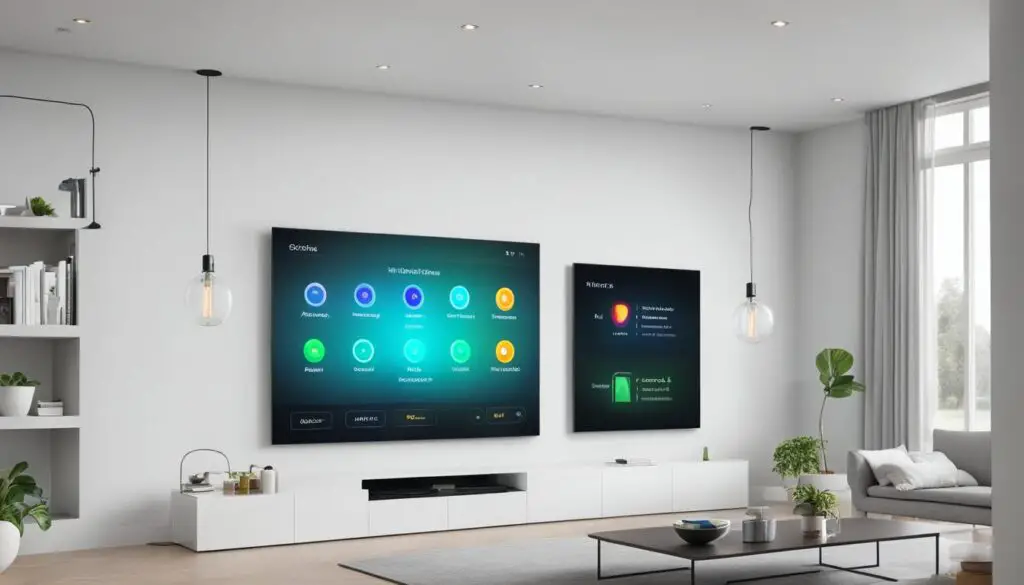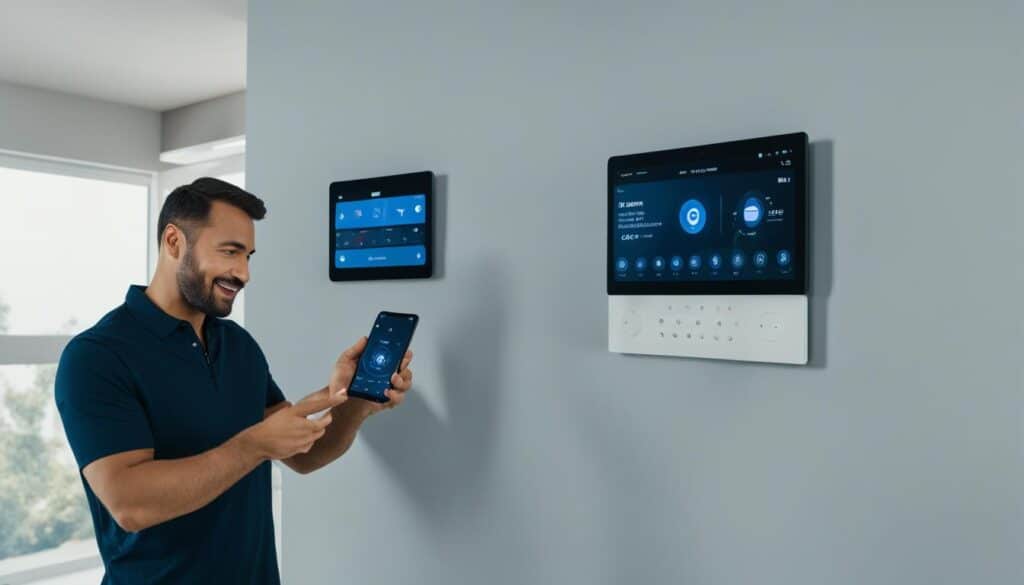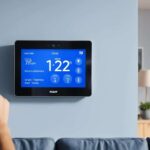Gone are the days when controlling your home’s lighting, temperature, and security involved manually flipping switches and adjusting thermostats. With wireless home automation, you can transform your house into a smart, efficient, and convenient space.
As a beginner, the idea of setting up a wireless home automation system might seem daunting. However, with the right advice and guidance, you can navigate the process seamlessly and unlock the full potential of a connected home.
Table of Contents
Key Takeaways:
- Wireless home automation enables you to control and manage various aspects of your smart home through wireless connections.
- It provides convenience, efficiency, and comfort by automating tasks and integrating different devices and systems.
- Understanding the basics of wireless home automation is crucial for making informed decisions and effectively utilizing the technology.
- There are different types of wireless home automation systems available, such as Wi-Fi, Zigbee, Z-Wave, and Bluetooth-based.
- Setting up a wireless home automation system involves choosing the right hub, connecting devices, configuring automation settings, and creating schedules.
Understanding Wireless Home Automation
Wireless home automation is revolutionizing the way we control and manage our homes. By harnessing the power of wireless technology, homeowners can now effortlessly automate various devices and systems, bringing convenience, efficiency, and comfort to their everyday lives.
When we talk about wireless home automation, we are referring to the use of wireless connections to control and automate devices in your home. This includes a wide range of smart devices, such as smart thermostats, smart lighting, smart security systems, and much more.
As a beginner, understanding the basics of wireless home automation is crucial to fully grasp the potential and possibilities it offers. By having a solid understanding of this technology, you can make informed decisions when choosing devices and effectively utilize them within your smart home ecosystem.
Smart Thermostats: Taking Control of Your Home’s Temperature
One example of a wireless home automation device is the smart thermostat. With a smart thermostat, you can adjust and control your home’s temperature from anywhere, at any time, using your smartphone or voice commands. This not only provides convenience but also helps you save energy and reduce utility costs.
“With a smart thermostat, I can effortlessly manage the temperature in my home, whether I’m at work or on vacation. It’s incredible how much control I have with just a few taps on my phone.”
– Emma, a homeowner who embraces wireless home automation
Smart Lighting: Creating the Perfect Ambiance
Another popular wireless home automation device is smart lighting. With smart light bulbs and switches, you can easily control your home’s lighting using your smartphone or voice commands. You can adjust brightness, color temperature, and even create schedules or scenes to set the perfect ambiance for any occasion.
“Smart lighting has transformed the way I interact with my home. I love being able to turn on/off lights from my bed or adjust the brightness without getting up. It’s a game-changer!”
– Jack, a wireless home automation enthusiast
By embracing wireless home automation, you gain the power to control and automate devices in your home from anywhere, simplifying day-to-day tasks and enhancing your overall living experience. Whether it’s adjusting the thermostat, turning on the lights, or even managing your security system, it’s all at your fingertips.
Types of Wireless Home Automation Systems
When it comes to wireless home automation systems, there are various types available in the market. Each type has its own advantages and compatibility with different devices, making it important to choose the right one for your specific needs. Let’s take a closer look at some of the common types:
1. Wi-Fi-based Systems:
Wi-Fi-based systems utilize your home’s existing Wi-Fi network to connect and control devices. They offer easy setup and broad compatibility, allowing you to integrate a wide range of smart devices into your automation system. From smart lights to thermostats and security cameras, Wi-Fi-based systems provide flexibility and convenience.
2. Zigbee:
Zigbee is a popular wireless communication protocol specifically designed for home automation. It operates on low power and can support a large number of devices, making it ideal for creating a comprehensive smart home network. Zigbee-based systems are known for their robustness and reliability, and they often use a central hub to connect and control devices.
3. Z-Wave:
Z-Wave is another widely used wireless protocol for home automation. Like Zigbee, it offers low power consumption and interoperability between different devices. Z-Wave devices typically form a mesh network, where each device can act as a signal repeater, ensuring strong connectivity throughout your home. These systems are known for their high level of compatibility and range.
4. Bluetooth-based Systems:
Bluetooth-based systems have gained popularity due to the widespread use of smartphones and other Bluetooth-enabled devices. They allow you to control and automate devices directly from your phone, offering convenience and accessibility. Bluetooth-based systems are often used for smaller-scale home automation applications, such as smart speakers and wearable devices.
Choosing the right type of wireless home automation system depends on factors such as the devices you want to integrate, the size of your home, and your specific requirements. Consider the features and compatibility of each system before making a decision.
Now that you have an understanding of the different types of wireless home automation systems available, it’s time to delve into setting up a system that suits your needs. But before we do that, let’s explore the steps involved in Setting Up a Wireless Home Automation System.

Setting Up a Wireless Home Automation System
Setting up a wireless home automation system is an exciting endeavor that can enhance the comfort and convenience of your living space. Follow these steps to ensure a smooth and successful installation:
- Choose the Right Hub or Control Device
The hub or control device is the central command center for your wireless home automation system. It allows you to manage and control all your connected devices from a single interface. Before making a decision, consider factors such as compatibility, range, and features.
Tip: Research different hubs or control devices available in the market and read reviews to find the one that best suits your needs.
- Connect Your Devices to the System
Once you have selected a hub or control device, it’s time to connect your devices to the system. This can be done either through the hub itself or by connecting them directly to your home network. Follow the manufacturer’s instructions for each device to ensure a secure and stable connection.
- Configure Automation Settings and Create Schedules
To fully leverage the capabilities of your wireless home automation system, you need to configure automation settings and create schedules or routines. This allows you to automate tasks like turning on lights at a specific time or adjusting the thermostat based on your preferences.
Tip: Experiment with different automation settings and schedules to find the perfect balance between comfort, energy efficiency, and convenience.

| Step | Description |
|---|---|
| 1 | Choose the right hub or control device |
| 2 | Connect your devices to the system |
| 3 | Configure automation settings and create schedules |
Once you have completed the setup process, you can begin enjoying the benefits of a wireless home automation system. Control your devices with ease, save energy, and create a more comfortable and convenient living environment.
Popular Wireless Home Automation Devices
When it comes to creating a smart and connected home, there are numerous popular devices that can be seamlessly integrated into a wireless home automation system. These devices offer a range of features and functionalities to enhance the convenience, comfort, and security of your living space.
Smart Thermostats
One of the most popular wireless home automation devices is the smart thermostat. Brands like Nest, Ecobee, and Honeywell offer thermostats that can learn your preferences, adjust temperature settings automatically, and even be controlled remotely using your smartphone or voice commands.
Smart Lights
Transform your lighting experience with smart lights from brands like Philips Hue, Lutron, and Lifx. These devices allow you to control the color, brightness, and scheduling of your lights, all from the convenience of your smartphone or using voice commands with virtual assistants like Amazon Alexa or Google Assistant.
Smart Locks
Enhance the security of your home with smart locks. Brands like August, Schlage, and Yale offer smart locks that allow you to lock and unlock your doors remotely, provide temporary access codes to guests, and receive notifications on any suspicious activity.
Smart Security Cameras
Keep an eye on your home with smart security cameras from Ring, Arlo, and Nest. These cameras offer features like motion detection, live video streaming, and cloud storage for recorded footage. You can monitor your home from anywhere, receive alerts, and even communicate through built-in speakers.
Smart Speakers
Add voice control and entertainment to your smart home with devices like Amazon Echo, Google Nest Hub, or Apple HomePod. These smart speakers allow you to play music, answer questions, control other smart devices, and perform various tasks using just your voice.
These are just a few examples of the popular wireless home automation devices available in the market. By integrating these devices into your smart home system, you can enjoy the convenience, energy efficiency, and peace of mind that wireless home automation brings.
Enhance the convenience, comfort, and security of your home with these popular wireless devices.
Troubleshooting and Maintenance Tips
Like any technology, wireless home automation systems may encounter issues or require maintenance. To ensure smooth operation of your system, here are some troubleshooting and maintenance tips:
- Check Connections: Make sure all the devices in your wireless home automation system are properly connected. Loose or faulty connections can lead to communication problems. Ensure that all cables and wires are securely plugged in and check for any damaged components.
- Reboot Devices: If you encounter any issues with specific devices or functions, try rebooting them. Turning off the device and turning it back on can often resolve temporary glitches or connectivity issues.
- Software and Firmware Updates: Regularly check for software and firmware updates for your devices and control hub. Manufacturers often release updates to improve performance, add new features, and fix software bugs. Keeping your system up to date can help prevent compatibility issues and ensure optimal performance.
- Replace Batteries: If your wireless home automation devices are battery-powered, it’s essential to regularly check and replace the batteries. Low battery levels can cause devices to malfunction or lose connectivity. Refer to the manufacturer’s instructions for specific battery replacement recommendations.
- Clean Devices: Dust and debris can accumulate on smart devices, affecting their performance and functionality. Clean your devices regularly using a soft cloth or the manufacturer’s recommended cleaning method. Avoid using harsh cleaning agents or spraying directly on the devices.
- Monitor for Software Updates: In addition to updating the software and firmware of your devices, it’s crucial to keep an eye out for system updates from your wireless home automation provider. These updates may include enhancements, bug fixes, and security patches. Stay informed and promptly install any recommended updates.
Regular troubleshooting and maintenance tasks can help troubleshoot common issues and ensure the efficient operation of your wireless home automation system.
Note: Regular maintenance and troubleshooting will help keep your wireless home automation system running smoothly.
Expanding Your Wireless Home Automation System
Now that you have set up your initial wireless home automation system, the possibilities for expansion and customization are endless. By adding more devices, you can further enhance the functionality and convenience of your smart home. Consider your needs and priorities to determine which additional devices would best suit your lifestyle.
Before expanding your system, it is essential to ensure compatibility with your existing setup. Not all devices will seamlessly integrate with your current wireless home automation system, so it’s crucial to do thorough research and choose devices that are compatible.
Here are a few common devices that you can consider adding to your wireless home automation system:
- Smart thermostats: Control and adjust the temperature in your home remotely, saving energy and ensuring a comfortable environment.
- Smart lighting: Set the perfect ambiance in any room and control your lights remotely, even when you’re away from home.
- Smart locks: Enhance the security of your home by adding smart locks that can be controlled and monitored through your smartphone.
- Smart security cameras: Keep an eye on your home at all times with smart security cameras that offer live streaming and motion detection features.
- Smart speakers: Enjoy a seamless audio experience by adding smart speakers to your home automation system, allowing you to control your music and other smart devices through voice commands.
Remember to check the compatibility of each device with your wireless home automation system before making a purchase. This will ensure that you can fully integrate and control all your devices from a single hub or control device.
Expanding your wireless home automation system is not only about adding more devices, but also about customizing them to fit your specific needs. Create schedules or routines, automate tasks, and explore the various features and functionalities of your devices to make the most out of your smart home experience.
Comparison of Compatible Devices for Wireless Home Automation Systems
| Device | Compatibility | Features |
|---|---|---|
| Smart Thermostats | Compatible with most wireless home automation systems | Remote temperature control, energy-saving features |
| Smart Lighting | Compatible with most wireless home automation systems | Remote control, customization options, energy efficiency |
| Smart Locks | Compatibility varies, check with manufacturer | Remote access, keyless entry, security features |
| Smart Security Cameras | Compatibility varies, check with manufacturer | Live streaming, motion detection, cloud storage |
| Smart Speakers | Compatible with most wireless home automation systems | Voice control, music streaming, integration with virtual assistants |
As you expand your wireless home automation system, be sure to explore the possibilities and take advantage of the features and functionalities offered by each device. With careful consideration and planning, you can create a truly connected and efficient smart home.
Conclusion
Wireless home automation revolutionizes the way we live by transforming our homes into smart, efficient, and convenient spaces. By automating tasks and integrating different devices and systems, wireless home automation offers beginners the opportunity to simplify their lives and enjoy the benefits of a connected home.
Setting up a wireless home automation system may seem daunting at first, but with the right advice and understanding, it can be a rewarding experience. Researching and choosing the best devices and systems that fit your needs is crucial. Whether it’s a smart thermostat to optimize energy usage, smart lights to create ambiance, or smart security systems to enhance safety, investing time in selecting the right devices will maximize the potential of your wireless home automation system.
With wireless home automation, you can have control at your fingertips. From adjusting the temperature before you arrive home to turning off the lights with a simple voice command, the convenience and comfort it offers is unmatched. Enjoy the ease of managing your home from anywhere, enhancing your lifestyle and saving time.
In conclusion, wireless home automation empowers beginners to create connected, intelligent homes. With the right knowledge and guidance, you can seamlessly set up a wireless home automation system to optimize your home’s functionality and elevate your living experience.
FAQ
What is wireless home automation?
Wireless home automation refers to the use of wireless technology to control and automate devices in your home. It allows you to manage various aspects of your smart home through wireless connections.
How can wireless home automation benefit beginners?
Wireless home automation provides convenience, efficiency, and comfort by automating tasks and integrating different devices and systems. It can transform your home into a smart, efficient, and convenient space.
What are the different types of wireless home automation systems available?
There are various types of wireless home automation systems available, including Wi-Fi-based systems, Zigbee, Z-Wave, and Bluetooth-based systems. Each type has its own advantages and compatibility with different devices, so it’s important to choose the right one for your needs.
How do I set up a wireless home automation system?
Setting up a wireless home automation system involves several steps. You need to choose the right hub or control device, connect your devices to the system, and configure automation settings and schedules. It may seem overwhelming at first, but with the right advice, it can be a seamless process.
What are some popular wireless home automation devices?
There are many popular devices that can be integrated into a wireless home automation system, such as smart thermostats, smart lights, smart locks, smart security cameras, and smart speakers. These devices offer various features and functionalities to enhance the convenience and security of your home.
What should I do if I encounter issues with my wireless home automation system?
If you encounter issues with your wireless home automation system, troubleshooting tips include checking connections, rebooting devices, and ensuring software and firmware are up to date. Regular maintenance, such as replacing batteries and monitoring for software updates, can also help keep your system running smoothly.
Can I expand my wireless home automation system?
Yes, you can expand your wireless home automation system over time. Before adding additional devices, consider your needs and compatibility with your existing system. Choose devices that can seamlessly integrate with your setup to enhance the functionality of your smart home.
What is the benefit of wireless home automation for beginners?
Wireless home automation offers beginners the opportunity to transform their homes into smart, efficient, and convenient spaces. With the right advice and understanding, setting up a wireless home automation system can be a rewarding experience.


